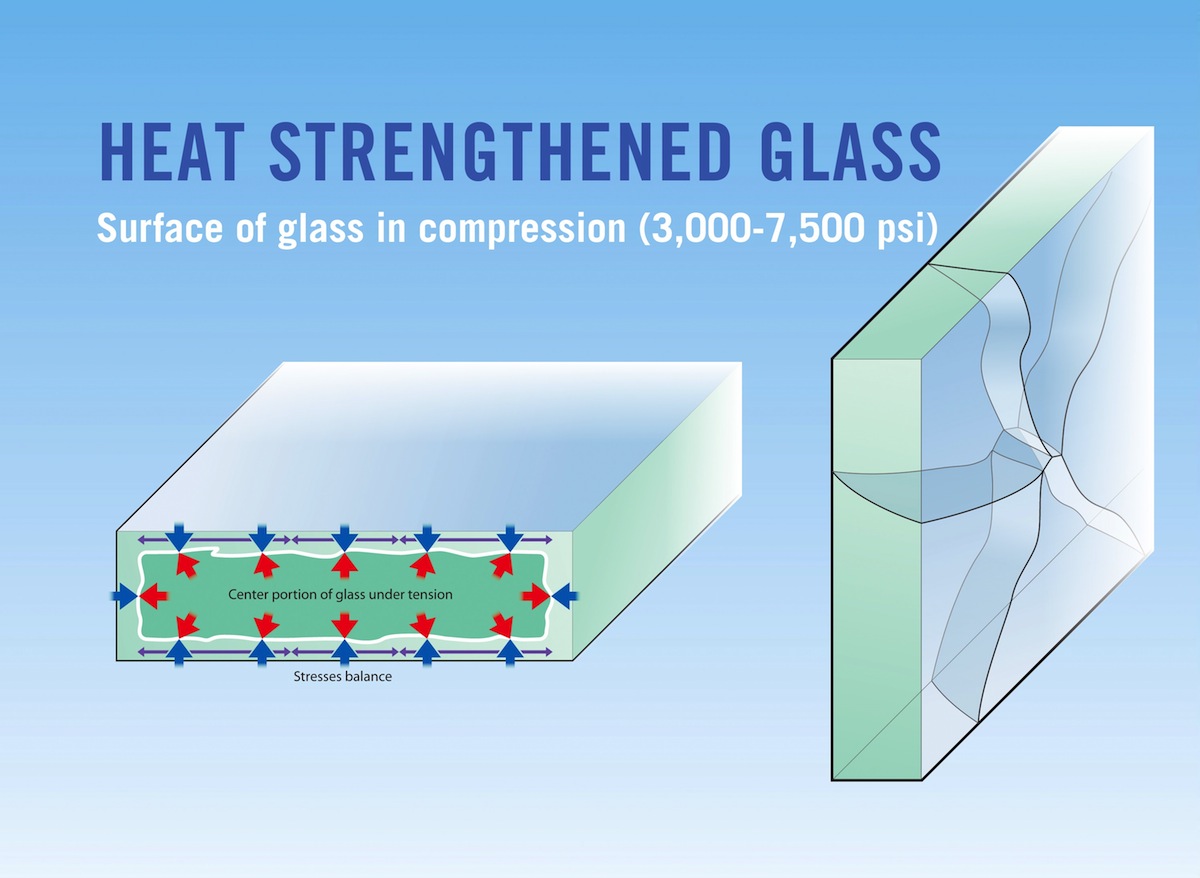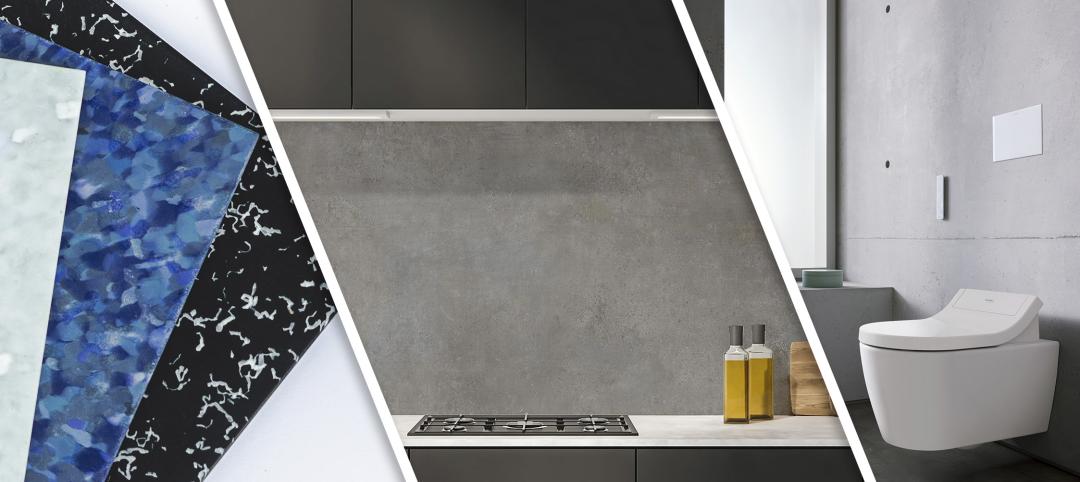Glass is heat-treated for two reasons: the first is to increase its strength to resist external stresses such as wind and snow loads, or thermal loads caused by the sun’s energy.
The second is to temper glass so that it meets safety glazing requirements defined by applicable codes or federal standards.
Following are a dozen quick tips about tempered and heat-strengthened glass, including why the strongest glass isn’t always the best glass for a given application.
1. Fabrication first. Because of the high internal stresses caused by heat-strengthening or tempering glass, all fabrication, including cutting, hole-drilling, notching or edge treatment, must be performed before glass is heat-treated.
2. Defining heat-treated glass. In North America, the standard specification for heat-treated glass is ASTM C1048 Standard Specification for Heat-Strengthened and Fully Tempered Glass. In general, heat-treated glass is at least two to four times stronger than annealed (untreated) glass.
3. Rate of cooling determines strength. During heat treatment, annealed (untreated) glass lites are heated to approximately 1,200 degrees F, then “quenched” in cold air. Cooled rapidly, glass tempers. Slower cooling produces heat-strengthened glass.
4. Tempered is stronger. Tempered glass has a minimum surface compression of 10,000 pounds-per-square-inch (psi) and minimum edge compression of 9,700 psi, according to ASTM C1048. That makes it about four times stronger than annealed glass. Heat-strengthened glass has surface compression of 3,500 to 7,500 psi, about twice as strong as annealed glass, with no edge compression standard.
5. Tempered glass is safety glass. When broken by impact, fully tempered glass shatters into tiny particles, reducing the potential for serious injury by flying shards of glass. For this reason, building codes require safety glazing in specific locations.
6. Stronger, yet more vulnerable. Ironically, the rapid temperature change that gives tempered glass its compression strength may also cause it to shatter, seemingly without warning. On rare occasions, tiny inclusions, including nickel-sulfide, may be present in glass, which can expand during heat treatment, then stop when the glass is cooled and resume growth when the glass is exposed to high in-service temperatures (such as on the sunny exposure of a building). This “phase change” can cause tempered glass to shatter. Heat-strengthened glass is cooled more slowly; consequently, inclusions do not experience a phase change, which essentially eliminates the possibility of spontaneous glass failure.
7. Heat-strengthened glass is not a safety glass. Though heat-strengthened glass may meet requirements for wind, snow and thermal loads, it is not considered a safety glazing. Heat-strengthened glass does not shatter when broken, but fractures into larger, sharper pieces that can become projectiles in a tornado, hurricane, explosion or fire.
8. Avoiding fall-out. Because it does not shatter, heat-strengthened glass tends to remain in the framing system after it is damaged, which makes it a better choice for applications where glass fall-out is a concern.
9. Lamination for consideration. Laminated interlayers, required for overhead glazing, can be used with annealed, heat-strengthened or tempered glass to combine several safety advantages into a single glazing solution, including less risk of spontaneous breakage and glass fall-out, and increased resistance to wind loads, snow loads and thermal stress.
10. Distorted views. Heat-treatment can generate subtle roller waves in glass, which are more likely to occur in tempered glass than in heat-strengthened glass. This can cause heat-treated glass to distort reflected images, a problem that may be exacerbated when it is used in glazing units with multiple lites or a laminated interlayer.
11. Edge quality is critical. Poor edge quality – or edge damage during fabrication, delivery or installation – makes glass more likely to break, which can offset or negate any benefit associated with heat-strengthening or tempering.
12. Stronger isn’t always better. Although tempered glass is strongest, PPG recommends its use only where required by code as a safety glazing or for thermal stress or wind load. For other applications, annealed or heat-strengthened glass is recommended to reduce distortion and the risk of fallout and spontaneous breakage.
What is tempered glass?
Tempered glass, also known as toughened glass, goes through a process of extreme heating and rapid cooling during the manufacturing process. It is much stronger and harder than normal glass.
What is annealed glass?
Annealed glass, also known as standard glass, has been thermally treated and then slowly cooled. Annealed glass is a softer glass and is generally used when cost is a greater concern than strength or safety.
To learn more about the differences between tempered and heat-strengthened glass, or to find the best recommendation for a specific application, visit the PPG Glass Education Center at www.educationcenter.ppg.com.
Related Stories
ProConnect Events | Apr 23, 2024
5 more ProConnect events scheduled for 2024, including all-new 'AEC Giants'
SGC Horizon present 7 ProConnect events in 2024.
75 Top Building Products | Apr 22, 2024
Enter today! BD+C's 75 Top Building Products for 2024
BD+C editors are now accepting submissions for the annual 75 Top Building Products awards. The winners will be featured in the November/December 2024 issue of Building Design+Construction.
Building Materials | Apr 22, 2024
Tacoma, Wash., investigating policy to reuse and recycle building materials
Tacoma, Wash., recently initiated a study to find ways to increase building material reuse through deconstruction and salvage. The city council unanimously voted to direct the city manager to investigate deconstruction options and estimate costs.
Brick and Masonry | Apr 4, 2024
Best in brick buildings: 9 projects take top honors in the Brick in Architecture Awards
The Ace Hotel Toronto, designed by Shim-Sutcliffe Architects, and the TCU Music Center by Bora Architecture & Interiors are among nine "Best in Class" winners and 44 overall winners in the Brick Industry Association's 2023 Brick in Architecture Awards.
Products and Materials | Mar 31, 2024
Top building products for March 2024
BD+C Editors break down March's top 15 building products, from multifamily-focused electronic locks to recyclable plastic panels.
Sustainability | Mar 21, 2024
World’s first TRUE-certified building project completed in California
GENESIS Marina, an expansive laboratory and office campus in Brisbane, Calif., is the world’s first Total Resource Use and Efficiency (TRUE)-certified construction endeavor. The certification recognizes projects that achieve outstanding levels of resource efficiency through waste reduction, reuse, and recycling practices.
Building Tech | Feb 20, 2024
Construction method featuring LEGO-like bricks wins global innovation award
A new construction method featuring LEGO-like bricks made from a renewable composite material took first place for building innovations at the 2024 JEC Composites Innovation Awards in Paris, France.
Industry Research | Jan 31, 2024
ASID identifies 11 design trends coming in 2024
The Trends Outlook Report by the American Society of Interior Designers (ASID) is the first of a three-part outlook series on interior design. This design trends report demonstrates the importance of connection and authenticity.
Products and Materials | Jan 31, 2024
Top building products for January 2024
BD+C Editors break down January's top 15 building products, from SloanStone Quartz Molded Sinks to InvisiWrap SA housewrap.
Sponsored | BD+C University Course | Jan 17, 2024
Waterproofing deep foundations for new construction
This continuing education course, by Walter P Moore's Amos Chan, P.E., BECxP, CxA+BE, covers design considerations for below-grade waterproofing for new construction, the types of below-grade systems available, and specific concerns associated with waterproofing deep foundations.
















